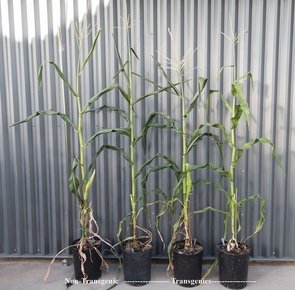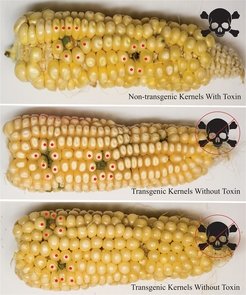
Researchers at the University of Arizona have found a promising way to prevent the loss of millions of tons of crops to a fungus each year, offering the potential to dramatically improve food security, especially in developing countries. The team’s approach uses transgenic corn plants that produce small RNA molecules that prevent fungi from producing aflatoxin, highly toxic substances that can render an entire harvest unsafe for human consumption even in small amounts.

The three transgenic corn plants appear comparable in the non-transgenic control plant. (Photo: Monica Schmidt)
Crops all over the world are susceptive to infection by fungi of various Aspergillus species, a fungus that produces secondary metabolites known as aflatoxins. These compounds have been implicated in stunting children’s growth, increasing the risk for liver cancer, and making people more susceptible to diseases such as HIV and malaria.
Unlike in the U.S., where crops intended for human consumption are tested for aflatoxin and incinerated once levels approach 20 parts per billion (equivalent to one drop of water in a 22,

These corn cobs show the sites where they were infected with Aspergillus fungus. Although non-transgenic and transgenic kernels showed evidence of equal infection, the transgenics accumulated no toxin. Red dots mark the kernels harvested by the researchers to then determine toxin levels. (Photo: Monica Schmidt)
Funded by the Bill and Melinda Gates Foundation, Schmidt and her team set out to study whether a naturally occurring biological mechanism called RNA interference could be used as a weapon against the Aspergillus toxin. That approach, called
«When I read about this in the literature, I thought, 'Why can’t we make a Trojan horse to shut off that toxin?'" said Schmidt, who has been working on this project for years. «We introduced an engineered DNA construct into the corn that passes the RNA into the fungus when it infects the corn plant.»
The modified corn plants carry a genetic blueprint for small RNA molecules, each only about 20 base pairs long, only in the edible kernels, not the whole plant.
«The corn is constantly producing that RNA during the entire development of the kernel," Schmidt explained. «When the kernels come in contact with the fungus, the RNA moves over into the fungus.»
Once inside the fungal cells, the
The HIGS approach has a distinctive advantage over existing efforts to keep aflatoxin out of the human food chain, because it prevents the fungus from making toxin in the first place while the crop is growing in the field, as opposed to protecting crops only after they have been harvested and stored. Such approaches include
Another strategy, pioneered by study
Other researchers have tried breeding varieties of corn that express antifungal proteins, but because not many antifungal proteins are known to begin with, those efforts have had limited success, Schmidt said.
HIGS holds great promise because it is highly specific and targeted in its effect, Schmidt explained, and could potentially be applied to other crops as well. Schmidt is collaborating with Tech Launch Arizona, the office of the UA that commercializes inventions stemming from research, to bring the technology to the marketplace. A patent has been filed.
In their experiments, the team infected corn plants with Aspergillus and let them grow for one month. While untreated control plants were found to harbor toxin levels between 1,000 and 10,000 per billion, toxin levels were undetectable in the transgenic plants.
«The detection limit is not zero, but low enough for the corn to be safe to eat," Schmidt said.
The team took the project a step further and investigated overall gene expression in kernels to see if the transgenic corn plants come with undesired side effects. This involved
«This corn plant would be like any other," she said. «The only trait that sets it apart is its ability to shut down the toxin production. It shouldn’t have any other effects, but obviously, a lot of downstream testing will be required before it could be grown in the fields.»
Schmidt and her team chose the open access journal Science Advances specifically because «we want anyone with an internet connection to be able to access our results, especially in Africa, where aflatoxin is such a big challenge to food security.»
Source: https://uanews.arizona.edu/story/small-molecule-could-play-role-food-security


